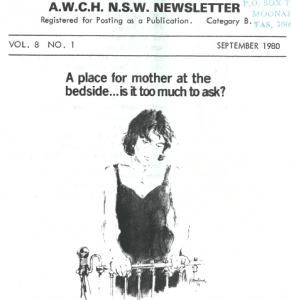Moment of panic
 A brown blob appeared momentarily in my peripheral vision and disappeared, I stopped. Continuing on, the motion of my swinging hair caused the reappearance of the brown blob. Standing still, I sensed a slight weight, something was there… and it was starting to move.
A brown blob appeared momentarily in my peripheral vision and disappeared, I stopped. Continuing on, the motion of my swinging hair caused the reappearance of the brown blob. Standing still, I sensed a slight weight, something was there… and it was starting to move.
A moment of panic ensued and with a hasty flick, the small huntsman spider dropped to the floor, scuttling across tiles, sinking low into a groove, not daring to move. This young Huntsman with brown translucent legs, had been taken from familiar surroundings and catapulted into a strange environment – my bathroom.
Mum’s sleeping on the floor
This reminded me of a different kind of fear, not of spiders but of fear and children in hospital. I’d just read an article written in 1982 about one parent’s experience* with her seven-year old in hospital. Her sick boy, Sam, was in a ward with other children also taken to hospital in an emergency. If I were to give her article a title I might call it, “Why I chose to camp on the hospital floor”.
Not long ago the expectation was that parents didn’t stay with their children in hospital and visiting hours were restricted (a paediatric nurse at a Sydney children’s hospital recalls many tears as visiting time on Sunday afternoons finished). The impact on many children, especially young children was large. Following AWCH’s recommendations, Australian hospitals began promoting family centered policies, parents were encouraged to stay.
This parent’s experience is worth reading because she challenged expectations in a leading children’s hospital, her story was firstly published in the Age newspaper, then AWCH magazine, Interface*.
Fear and separation
The mum, Janet, gave a moving account of five nights with her son in hospital. She knew staying would be best. This was reinforced when on the first night, another child awoke screaming, a nurse rushed in and this panicked child grabbed her crying “Mummy come quick”.
The child in a bed nearby had been taken from home, was sick and separated from his family. Hospital was a strange and frightening place. He had an intravenous drip and splint attached to his arm. Later, a two year old was screaming and inconsolable, her mother had gone home. The nurse had given sedation to stop crying.
 |
| Poster was one of six from AWCH (SA) issued by NAWCH, London, 1978 |
To go home or stay on the floor?
Sam’s mum, it had been suggested, should go home because her son was old enough that “he should be able to cope”. With an upright chair to sleep in, Janet stayed. At 3 am another nurse approached her with a strip of foam rubber and a towel, she “hit the floor with relief”. The next night she had a sleeping bag from home. Janet experienced some odd looks from hospital staff but she was pretty much ignored. This mum was courageous, doing what she thought was best for her child despite hospital protocol.
At home, Janet revisited scenes of children screaming for their parents. Her greatest affirmation came from Sam. Hugging her close, in a whispering voice he said: “thanks for staying with me in hospital mum”.
“thanks for staying with me in hospital mum”
AWCH helps children
AWCH “pioneers” were also courageous, working hard to change care for children and young people in hospital. They were part of a social movement, linking with international
sister organisations. AWCH’s first benchmark policy,
A recommended health care policy relating to children and their families, was published in Medical Journal of Australia, 1974.
Your Child in Hospital (pamphlet),.a Joint effort of Division of Health Education and AWCH, was significant as the first Australian education of parents about sick children and hospital. Written between the lines was a reminder to health professionals of their role in caring for children. With great interest, ¼ million pamphlets were printed.
AWCH continues to produce policies, work with key stakeholders (CT scans – information for parents and carers), guide the provision and advocate for rights of children and young people in healthcare.
AWCH Ward Grandparent scheme supports children and parents or carers in hospital. Volunteer grannies, recognise it isn’t possible for parents or carers to always stay with their child.
Your comments and impressions are welcome and can be added below.
 A brown blob appeared momentarily in my peripheral vision and disappeared, I stopped. Continuing on, the motion of my swinging hair caused the reappearance of the brown blob. Standing still, I sensed a slight weight, something was there… and it was starting to move.
A brown blob appeared momentarily in my peripheral vision and disappeared, I stopped. Continuing on, the motion of my swinging hair caused the reappearance of the brown blob. Standing still, I sensed a slight weight, something was there… and it was starting to move.



